| Revision as of 16:52, 21 April 2015 edit74.105.242.145 (talk)No edit summary← Previous edit | Revision as of 16:55, 21 April 2015 edit undo74.105.242.145 (talk)No edit summaryNext edit → | ||
| Line 32: | Line 32: | ||
| Ness Ziona was first known as Wadi Chanin after the local Arab village, and Nahalat Reuben (lit. "Reuben's Estate") after Reuben Lehrer, who owned the land and started the Jewish settlement there in 1883. | Ness Ziona was first known as Wadi Chanin after the local Arab village, and Nahalat Reuben (lit. "Reuben's Estate") after Reuben Lehrer, who owned the land and started the Jewish settlement there in 1883. | ||
| In 1878, the ] ] Gustav Reisler purchased lands in ], planted an orchard, and lived there with his family. The name "Wadi-Chanin", with its German orthography, became the standard Western name for the place for several decades to come. After losing his wife and children to malaria, Reisler returned to Europe. He travelled to ] in 1882 and met Reuben Lehrer, a religiously observant Russian Jew with Zionist ideals, who had his own farmland there. Reisler traded his parcel of land in Israel for Lehrer's land in Russia. Lehrer made ] (emigrated to |
In 1878, the ] ] Gustav Reisler purchased lands in ], planted an orchard, and lived there with his family. The name "Wadi-Chanin", with its German orthography, became the standard Western name for the place for several decades to come. After losing his wife and children to malaria, Reisler returned to Europe. He travelled to ] in 1882 and met Reuben Lehrer, a religiously observant Russian Jew with Zionist ideals, who had his own farmland there. Reisler traded his parcel of land in Israel for Lehrer's land in Russia. Lehrer made ] (emigrated to Israel) with his eldest son Moshe in 1883, bringing his wife and another four of his children over the following year.<ref name="muni history">{{cite web|url=https://web.archive.org/web/20100430210950/http://www.ness-ziona.muni.il/Htmls/English/ARTICLE.html|title=Ness Ziona - The Flag of Zion!|author=Young, Daphne|publisher=Ness Ziona Municipality|accessdate=February 2015}}</ref><ref name="hareuveni lexicon">{{cite book|title=Lexicon of the Land of Israel|publisher=Miskal - Yedioth Ahronoth Books and Chemed Books|language=Hebrew|year=1999|first=Immanuel|last=HaReuveni|pages=692|isbn=965-448-413-7}}</ref><ref>http://www.nzc.org.il/?CategoryID=209&ArticleID=377</ref> | ||
| Lehrer placed advertisements near ] port asking others to join him. The pioneers established a neighborhood named Tel Aviv (the city of ] did not yet exist) although the area was still known as Wadi Chanin, from its Arabic name, Wadi Hunayn.<ref name="hareuveni lexicon"/> In 1888, Avraham Yalovsky, a ], was killed defending his property from Arab gangs.<ref>{{cite web|title=Yalovsky, Avraham - Life Story|url=http://www.izkor.gov.il/izkor86.asp?t=505868|publisher=]|accessdate=2008-10-22|language=he}}</ref> | Lehrer placed advertisements near ] port asking others to join him. The pioneers established a neighborhood named Tel Aviv (the city of ] did not yet exist) although the area was still known as Wadi Chanin, from its Arabic name, Wadi Hunayn.<ref name="hareuveni lexicon"/> In 1888, Avraham Yalovsky, a ], was killed defending his property from Arab gangs.<ref>{{cite web|title=Yalovsky, Avraham - Life Story|url=http://www.izkor.gov.il/izkor86.asp?t=505868|publisher=]|accessdate=2008-10-22|language=he}}</ref> | ||
| Line 40: | Line 40: | ||
| ===United village=== | ===United village=== | ||
| Eventually, the two Jewish colonies - the old Wadi Chanin/Nahalat Reuben and the newer Ness Ziona - grew into one larger village, together with the Arab Wadi Hunayn across the Jaffa-Jerusalem road. Until the ], it was the only mixed Arab-Jewish village in Mandate |
Eventually, the two Jewish colonies - the old Wadi Chanin/Nahalat Reuben and the newer Ness Ziona - grew into one larger village, together with the Arab Wadi Hunayn across the Jaffa-Jerusalem road. Until the ], it was the only mixed Arab-Jewish village in Mandate Israel. The coexistence was, on the whole, a peaceful one.<ref>https://www.jewishvirtuallibrary.org/jsource/judaica/ejud_0002_0015_0_14703.html</ref> | ||
| ===British Mandate=== | ===British Mandate=== | ||
| In 1924 the British Army contracted the |
In 1924 the British Army contracted the Israel Electric Company for wired electric power. The contract allowed the Electric Company to extend the grid beyond the original geographical limits that had been projected by the concession it was given. The high-tension line that exceeded the limits of the original concession ran along some major towns and agricultural settlements, offering extended connections to the Jewish settlements of Rishon Le-Zion, Nes-Ziona and Rehovot (in spite of their proximity to the high-tension line, the Arab towns of Ramleh and Lydda remained unconnected).<ref>Shamir, Ronen (2013) Current Flow: The Electrification of Israel. Stanford: Stanford University Press.</ref> | ||
| ===Arab attacks=== | ===Arab attacks=== | ||
| ] | ] | ||
| Ness Ziona was attacked by Arab forces in the ], and the 1948 Arab–Israeli War. The outlying villages of Kfar Aharon and Tirat Shalom (now part of Ness Ziona) frequently exchanged fire with the Arab villages ] and ] (now western ]).<ref name="110 years">{{cite book|title=Ness Ziona - 110 Years|year=1993|author=Regev, Yoav|location=Tel Aviv, Israel|pages=48–51|language=Hebrew}}</ref> Most of Ness Ziona's youth joined the ] to fight off these threats. On May 15, 1948, Sarafand was evacuated of Arab inhabitants, and on May 19, al-Qubayba and Zarnuqa were conquered by the ]. Much of the territory abandoned by the fleeing Arab residents of nearby villages was added to Ness Ziona, increasing its size from {{convert|8|to|15.3|km²|1|abbr=out}} immediately after the war.<ref name="110 years"/> | Ness Ziona was attacked by Arab forces in the ], and the 1948 Arab–Israeli War. The outlying villages of Kfar Aharon and Tirat Shalom (now part of Ness Ziona) frequently exchanged fire with the Arab villages ] and ] (now western ]).<ref name="110 years">{{cite book|title=Ness Ziona - 110 Years|year=1993|author=Regev, Yoav|location=Tel Aviv, Israel|pages=48–51|language=Hebrew}}</ref> Most of Ness Ziona's youth joined the ] to fight off these threats. On May 15, 1948, Sarafand was evacuated of Arab inhabitants, and on May 19, al-Qubayba and Zarnuqa were conquered by the ]. Much of the territory abandoned by the fleeing Arab residents of nearby villages was added to Ness Ziona, increasing its size from {{convert|8|to|15.3|km²|1|abbr=out}} immediately after the war.<ref name="110 years"/> | ||
| ===After the establishment of the state=== | ===After the establishment of the state=== | ||
Revision as of 16:55, 21 April 2015
Template:Infobox Israel municipality Ness Ziona (Template:Lang-he-n, Nes Tziyona) is a city in central Israel founded in 1883. At the end of 2009 the city had a total population of 38,100, and its jurisdiction was 15,579 dunams.
History
Wadi Chanin/Nahalat Reuben
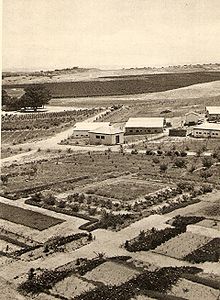
Ness Ziona was first known as Wadi Chanin after the local Arab village, and Nahalat Reuben (lit. "Reuben's Estate") after Reuben Lehrer, who owned the land and started the Jewish settlement there in 1883.
In 1878, the German Templer Gustav Reisler purchased lands in Wadi Hunayn, planted an orchard, and lived there with his family. The name "Wadi-Chanin", with its German orthography, became the standard Western name for the place for several decades to come. After losing his wife and children to malaria, Reisler returned to Europe. He travelled to Odessa in 1882 and met Reuben Lehrer, a religiously observant Russian Jew with Zionist ideals, who had his own farmland there. Reisler traded his parcel of land in Israel for Lehrer's land in Russia. Lehrer made aliyah (emigrated to Israel) with his eldest son Moshe in 1883, bringing his wife and another four of his children over the following year.
Lehrer placed advertisements near Jaffa port asking others to join him. The pioneers established a neighborhood named Tel Aviv (the city of Tel Aviv did not yet exist) although the area was still known as Wadi Chanin, from its Arabic name, Wadi Hunayn. In 1888, Avraham Yalovsky, a blacksmith, was killed defending his property from Arab gangs.
Ness Ziona, a separate colony
In 1891, Michael Halperin bought more land in the wadi. He gathered a group of people on the Hill of Love and unfurled a blue and white flag emblazoned with the words Ness Ziona ("Banner to Zion") written in gold. The name is based on a verse in the Book of Jeremiah, Jeremiah 4:6. This flag was similar to the official Flag of Israel adopted at the First Zionist Congress seven years later.
United village
Eventually, the two Jewish colonies - the old Wadi Chanin/Nahalat Reuben and the newer Ness Ziona - grew into one larger village, together with the Arab Wadi Hunayn across the Jaffa-Jerusalem road. Until the 1948 Arab–Israeli War, it was the only mixed Arab-Jewish village in Mandate Israel. The coexistence was, on the whole, a peaceful one.
British Mandate
In 1924 the British Army contracted the Israel Electric Company for wired electric power. The contract allowed the Electric Company to extend the grid beyond the original geographical limits that had been projected by the concession it was given. The high-tension line that exceeded the limits of the original concession ran along some major towns and agricultural settlements, offering extended connections to the Jewish settlements of Rishon Le-Zion, Nes-Ziona and Rehovot (in spite of their proximity to the high-tension line, the Arab towns of Ramleh and Lydda remained unconnected).
Arab attacks
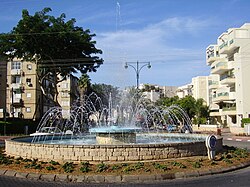
Ness Ziona was attacked by Arab forces in the 1936–39 Arab Revolt, and the 1948 Arab–Israeli War. The outlying villages of Kfar Aharon and Tirat Shalom (now part of Ness Ziona) frequently exchanged fire with the Arab villages al-Qubayba and Zarnuqa (now western Rehovot). Most of Ness Ziona's youth joined the Haganah to fight off these threats. On May 15, 1948, Sarafand was evacuated of Arab inhabitants, and on May 19, al-Qubayba and Zarnuqa were conquered by the Givati Brigade. Much of the territory abandoned by the fleeing Arab residents of nearby villages was added to Ness Ziona, increasing its size from 8 to 15.3 square kilometres (3.1 to 5.9 sq mi) immediately after the war.
After the establishment of the state
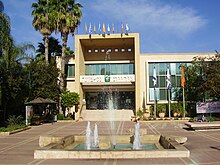
During the war, Ness Ziona's population almost tripled to become 4,446 (according to an October 23, 1949 survey), and until 1950 the local council absorbed 9,000 olim, most of whom were housed in ma'abarot. In 1952 a new industrial zone was approved for the town on an area of 70 dunams. In 1955, a second industrial zone was approved.
Geography
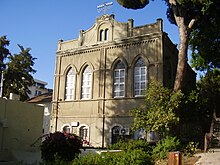
Ness Ziona is located on the Israeli coastal plain approximately 10 km (6 mi) inland of the Mediterranean Sea, to the south of Tel Aviv. The city is bordered to the north by Rishon LeZion, to the east by Be'er Ya'akov, and to the south by Rehovot. Beit Hanan, Beit Oved, Ayanot youth village and Kibbutz Netzer Sereni also border the city. The city has been designed to have a rural character due to urban planning that bans the construction of buildings higher than eight stories. Property values have risen by 30 percent in recent years.
Neighborhoods
Ness Ziona is composed of a central core and villages that came under its municipal jurisdiction over time. The city also has two industrial zones and a high-tech park, Kiryat Weizmann.
Demographics
According to the Israeli Central Bureau of Statistics (CBS), in 2005 the ethnic makeup of the city was 99.6% Jewish and other non-Arabs. At the end of 2004 there were 612 immigrants (2.2%), although this rose sharply to 7.8% in 2005. The city also receives significant internal migration, and is popular among Tel Aviv residents seeking to leave the city.
In 2005 there were 14,400 males and 14,900 females. 31.8% of the population was 19 years of age or younger, 15.2% between 20 and 29, 21% between 30 and 44, 19.1% from 45 to 59, 3.1% from 60 to 64, and 9.7% 65 years of age or older. The population growth rate in 2006 was 5.8%.
In 2005, there were 11,830 salaried workers and 984 self-employed. The mean monthly wage for a salaried worker was NIS 7,597, a 9.2% increase over 2000. Salaried males had a mean monthly wage of NIS 9,802 (an 8.4% increase) versus NIS 5,595 for females (a 14% increase). The mean income for the self-employed was 7,064. There were 290 people receiving unemployment benefits and 986 receiving an income guarantee (welfare).
Economy
Ness Ziona is home to the Israel Institute for Biological Research (IIBR), a secret government defence research institute working in chemical and biological research with 350 employees, and Zenith Solar, a solar energy company. The Kiryat Weizmann Science Park is a magnet for many Israeli start-ups, among them Indigo Digital Press, which was acquired by Hewlett-Packard in 2002 and manufactures high-end digital printing presses.
Education
| This section needs to be updated. Please help update this article to reflect recent events or newly available information. (October 2013) |
According to CBS figures for 2001, there are 13 schools and 5,019 students in the city: 10 elementary schools with 2,821 students, and 4 high schools with 2,198 students. 62.9% of 12th graders were eligible for a matriculation certificate that year.
Sports

The city has been represented in the top division of Israeli football by two different clubs; Maccabi Ness Ziona competed in the top flight in the first post-independence season. However, they lost all 24 games, and were relegated. A new club, Sektzia Ness Ziona was formed in 1956 and reached the top flight in 1966. However, they were relegated after only one season. After folding, they reformed as Ironi Ness Ziona in 2001, and since then have reverted to their former name and reached Liga Leumit, the second tier. The club plays at the Ness Ziona Stadium, which has also hosted Israel's U-19 team.
The town is also home to a basketball team, Ironi Nes Ziona B.C., playing in the national premier league.
Transportation
Ness Ziona has two main roads – Highway 42 to the west, and Road 412 (Weizmann Street), which goes through the city center and connects to Rishon LeZion and Rehovot. The Ness Ziona Central Bus Station is located on Weizmann Street, although as of 2008 it is operational only for buses heading north, while the platform for buses heading south was moved across the street.
Twin towns — Sister cities
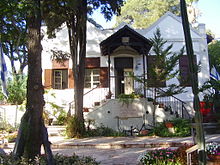
Ness Ziona is twinned with:
See also
References
- ^ "Table 3 - Population of Localities Numbering Above 2,000 Residents and Other Rural Population" (PDF). Israel Central Bureau of Statistics. 2010-06-30. Retrieved 2010-12-10.
- ^ "Local Authorities in Israel 2005, Publication #1295 - Municipality Profiles - Ness Ziona" (PDF) (in Hebrew). Israel Central Bureau of Statistics. Retrieved 2008-04-14.
- ^ Young, Daphne. "Ness Ziona - The Flag of Zion!". Ness Ziona Municipality. Retrieved February 2015.
{{cite web}}: Check date values in:|accessdate=(help) - ^ HaReuveni, Immanuel (1999). Lexicon of the Land of Israel (in Hebrew). Miskal - Yedioth Ahronoth Books and Chemed Books. p. 692. ISBN 965-448-413-7.
- http://www.nzc.org.il/?CategoryID=209&ArticleID=377
- "Yalovsky, Avraham - Life Story" (in Hebrew). Israel Ministry of Defense. Retrieved 2008-10-22.
- https://www.jewishvirtuallibrary.org/jsource/judaica/ejud_0002_0015_0_14703.html
- Shamir, Ronen (2013) Current Flow: The Electrification of Israel. Stanford: Stanford University Press.
- ^ Regev, Yoav (1993). Ness Ziona - 110 Years (in Hebrew). Tel Aviv, Israel. pp. 48–51.
{{cite book}}: CS1 maint: location missing publisher (link) - Lieberman, Guy. "Watch out, Tel Aviv!". Haaretz. Retrieved 2008-04-14.
- "Population and Density Per Sq. Km. in Localities Numbering Above 5,000 Residents" (PDF). Israel Central Bureau of Statistics. 2004-12-31. Retrieved 2008-04-26.
- The Observer newspaper: Marcus Klingberg: the spy who knew too much, 27 April 2014
- At the Zenith of Solar Energy, Neal Sandler, Businessweek, March 26, 2008
- "Israel - List of Final Tables". RSSSF. Retrieved 2008-10-22.
- "Twin Cities". Ness Ziona Municipality. Retrieved February 2015.
{{cite web}}: Check date values in:|accessdate=(help)
External links
| Central District of Israel | ||
|---|---|---|
| Cities |  | |
| Local councils | ||
| Regional councils | ||
| Boroughs | ||
| See also | ||